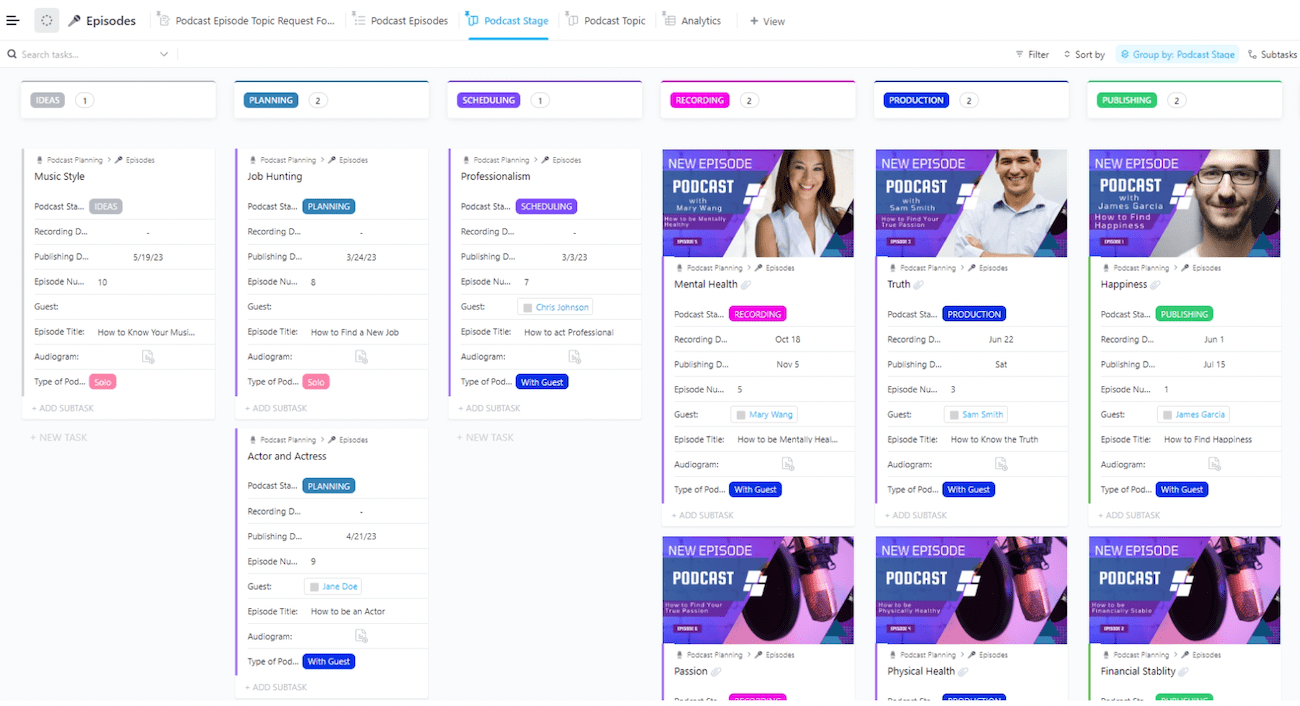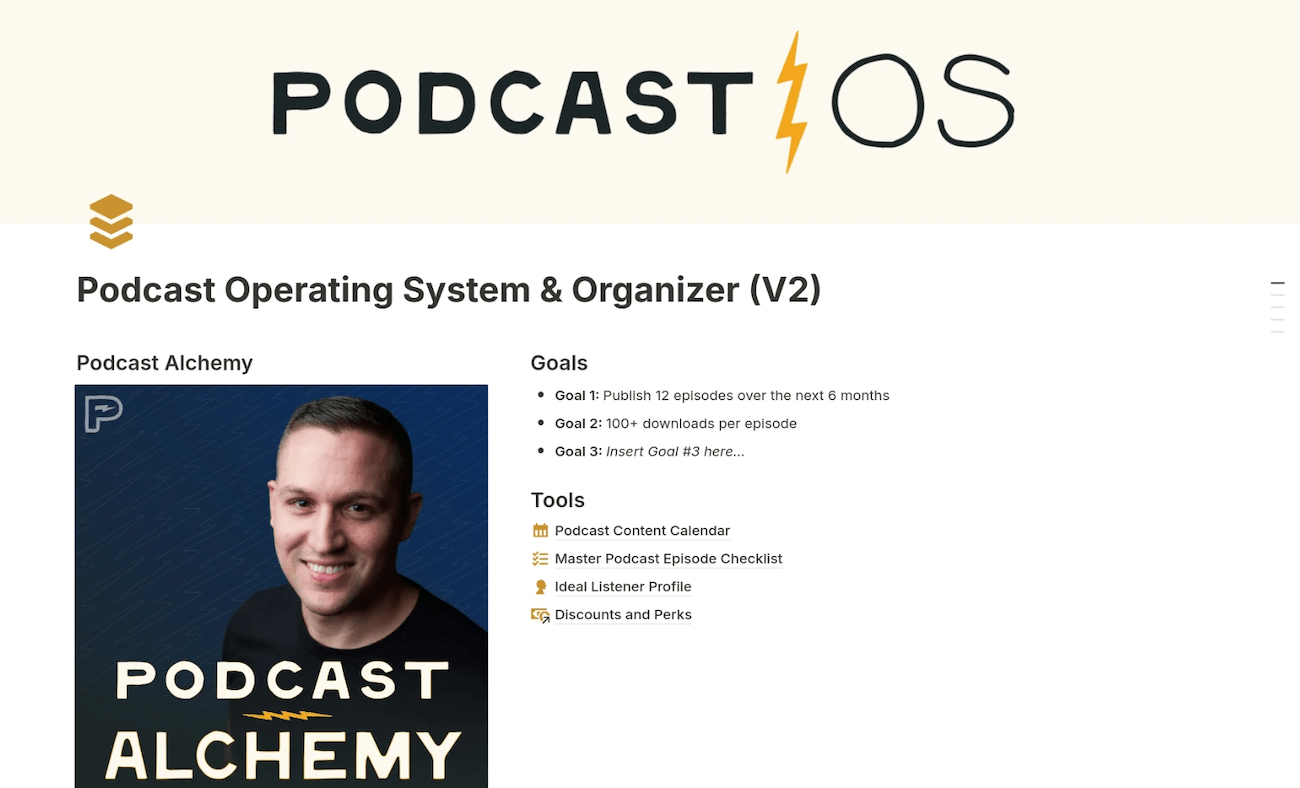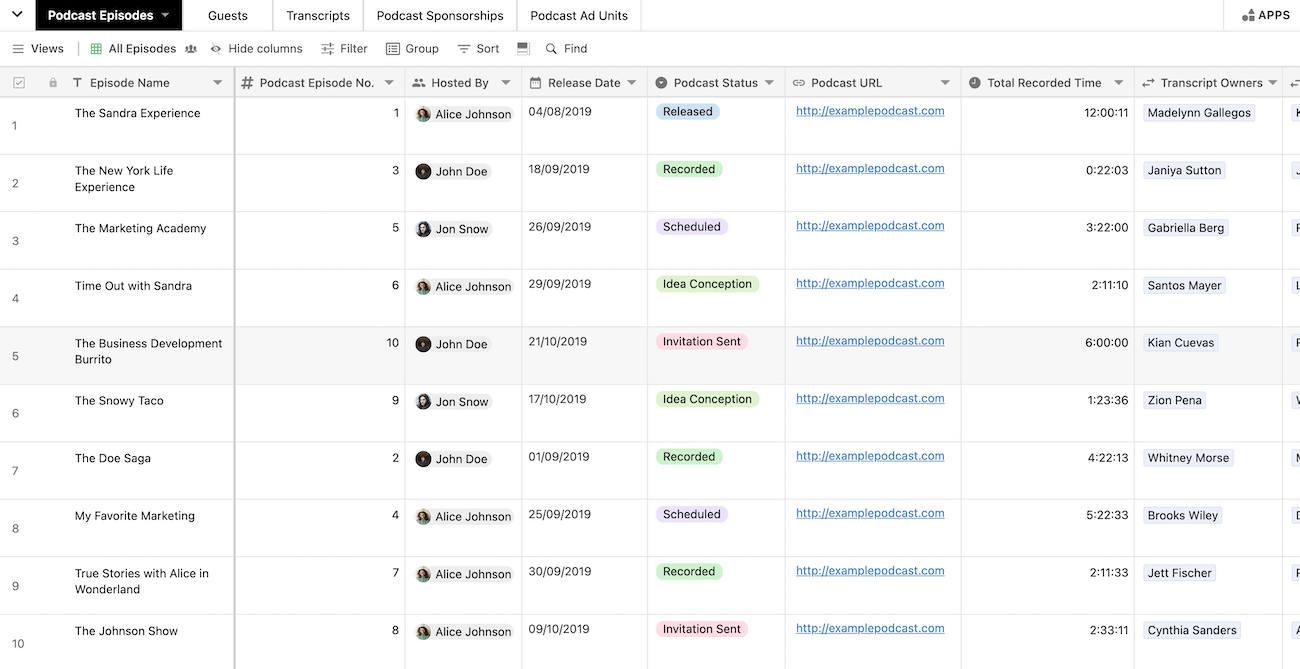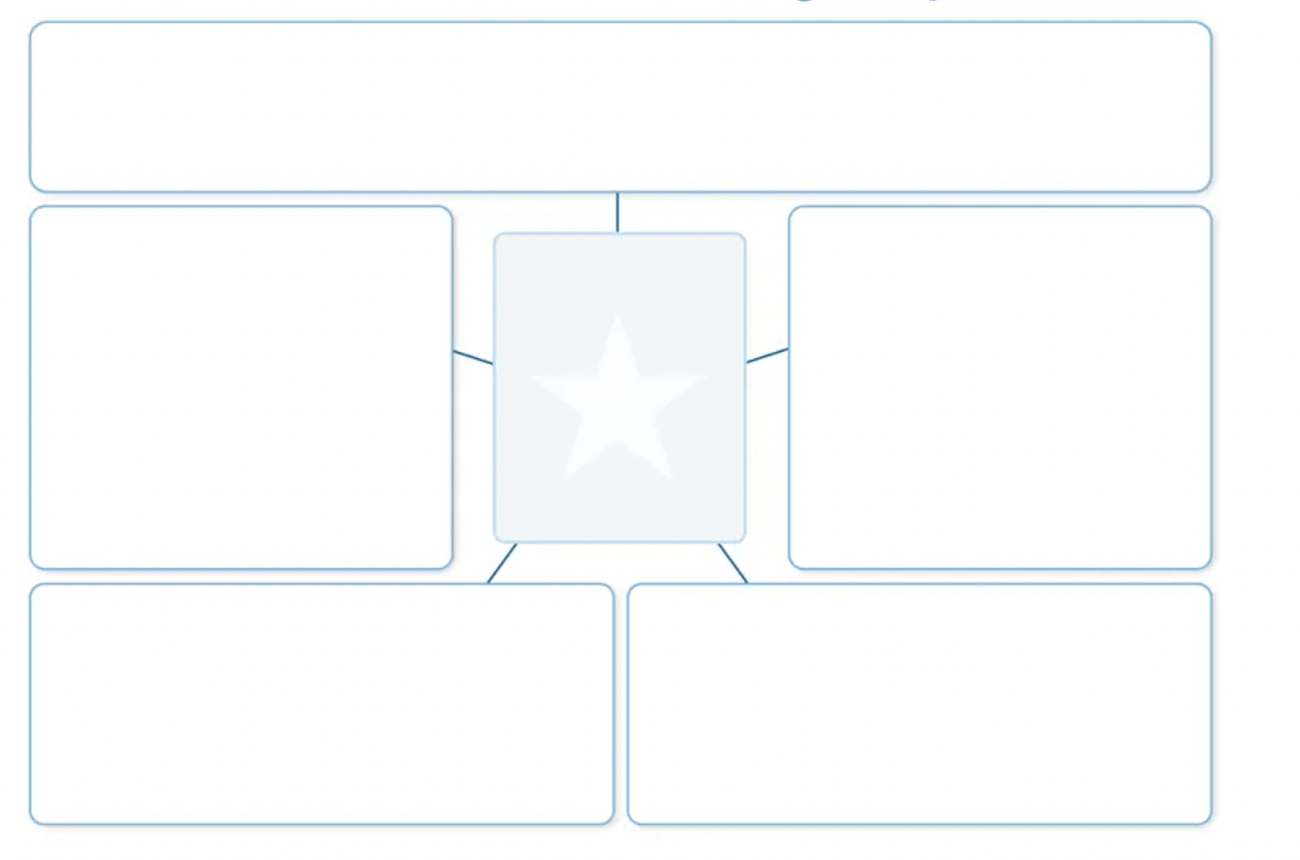From brainstorming ideas to booking guests and outlining show topics, there’s a lot of work involved with planning a podcast episode. Podcast planning templates can help you keep track of sponsors, manage your editing and production process, and even map out promotional content once your episodes go live.
These are some of my favorite options for beginners, seasoned hosts, and everyone in between.
Featured Partners
monday.com: A podcast planning template for smooth production
monday.com is one of my favorite project management tools on the market. It’s a great way to plan your podcast because it has everything you need to stay organized and ensure none of your production tasks slip through the cracks.
It also has a great mobile app, allowing you to manage podcast planning from the palm of your hand.
You can sign up for monday.com’s free plan to unlock access to 200+ templates, up to three project boards, eight custom column types, and seats for two collaborators. It’s a great place to start or try it out but most teams will likely need to upgrade to a paid plan rather quickly.
More on monday.com: monday.com Review | monday.com vs Wrike | monday.com vs Airtable.

I really like how the production flow is set up with this template. Instead of a single card for each episode that displays its status, every episode has its own list of dedicated tasks.
For example, the preparation phase may include tasks related to preparing questions for guests and outlining the episode structure. You can also have a post-production phase for things like editing clips to be promoted on social media before the final episode is polished and ready to live.
This kind of setup lets you get as granular as you’d like without cluttering everything up.
The template also lets you estimate how much time each task should take. From there, you can enter the actuals and compare the difference.
Overall, monday.com and this template are solid options for any podcaster, whether you’re working by yourself or with a full team. It’s easy to use, and the fact that you’re getting the full power of monday.com’s project management platform is a bonus that can’t be overlooked.
ClickUp: Podcast planning templates for any type of show
ClickUp is another all-in-one project management and team collaboration platform. While this might seem like overkill for podcast planning, there’s a free forever plan that’s perfect for organizing just about everything.
Each template below is more advanced than the one before it.
The right one for you depends on how much you want to lean on the tool, how many people you’re working with, and how granular you want to be with post-production tracking.
More on ClickUp: ClickUp Review | ClickUp vs monday.com | ClickUp vs Notion.
Template 1: A beginner-friendly option for planning episodes
This template is great for newer podcast hosts who just need something simple to plan upcoming episodes.
It comes with all of the basics you need to stay organized. You can create a backlog of episode ideas, categorize episodes, add audio files, and attach links to live episodes so everything’s centralized in one place.

My favorite part about this podcast planning template is its simplicity.
It’s organized into four sections that follow a linear flow — planned episodes, recorded episodes, shows that have been edited, and shows that have been published.
Because of its simplicity, you won’t have to spend a ton of time figuring out how it works. It’s just a matter of signing up and adding all of your ideas. Within minutes you’ll be more organized and have far more insight into where everything stands in your production flow.
The biggest downside is that it’s missing functionality for brainstorming, managing post-production tasks, and scaling beyond a single channel.
This isn’t necessarily a bad thing, especially for newer shows. But bigger production teams will likely need to go with one of the other templates below.
Template 2: Added features for managing different types of podcasts
This ClickUp template follows the same core concept of the previous one in the sense that all episodes are organized by stage in the production process.
But it takes it up a notch if you want more granular details about each episode.
You’ll see the progress status of each episode updated in real-time as you or your team completes tasks required to get it live.

This template comes pre loaded with 17 custom attributes that you can use tag episodes and stay organized.
These range from topic categories to listens, subscriber information, and more.
You’ll also be able to categorize each item by type. For each type, you can define a set structure that’s applied when you add a new episode, so you don’t have to outline all the steps every single time you add something new.
Say you’re planning an episode that includes a guest. If you tag that episode with this attribute, you can have your interview notes and questions available by default on that particular card.
I also love the visual elements of this template. If you want to have a broad range of topics for your show, the color-coded topic column clearly indicates whether you have a good mix of ideas or too many episodes in one category.
While you can use it to manage some post-production tasks, like your social media marketing plans, it’s a bit more limited for this use compared to the template below.
Template 3: The most advanced option for managing all pre and post-production tasks
If you have a well-established show with a full team working collaboratively to record, edit, and promote your show, this template has everything you’ll need to stay organized before, during, and after production.
I don’t recommend it for solo podcasters and simple shows or if you’re publishing less than an episode per week. You’ll end up wasting time filling in details that don’t matter yet.
But for teams producing episodes at scale, this template is a no-brainer.

You can set up multiple boards for different parts of the production flow. By default, there’s a brainstorming board, backlog of topic lists, and even a place to organize requests from your listeners.
Once shows go live, you can pull in analytics to see which topics are performing the best so you can replicate that success with future episodes.
From managing guest outreach and relationships with previous guests to planning social media posts and putting all episode assets in a single card, this template has it all.
There are multiple views, built-in statuses, collaborative documents, and a place to store all of your attachments.
Your producers, editors, social team, and designers will be able to keep track of all their work in one place, giving managers and supervisors everything they need to track progress and fix issues before they become larger problems.
Although ClickUp’s free plan is fine to start, you’ll need to upgrade to a paid plan to make the best use of all the advanced capabilities of this template.
Notion: Podcast planning templates created by professional podcasters
Notion is a connected workspace and productivity platform that’s great for taking notes, staying organized, managing tasks, and centralizing resources. If you work by yourself, you can use Notion’s free plan for quite some time. If you work with a team, the free plan is more of a free trial that lets you see if it’s right before you buy.
One of the best things about Notion is that third-party creators can submit templates to its marketplace. Two of my favorites were built by a professional podcaster with 10+ years of experience and 50+ million podcast downloads.
As such, you know they’ve been tested over time and used in real-world scenarios rather than created for the sake of adding a template to the list.
More on Notion: Notion Review | Notion vs Asana | Notion vs OneNote.
Template 1: A detailed checklist for pre and post-production
This podcast template ensures you leave no stone unturned when you’re planning, recording, and marketing your episodes.
It’s a comprehensive checklist with roughly 50 items — covering everything from outlining your episode to having water nearby and transcribing your episodes after they’ve been recorded.

While some of these things might seem obvious if you’re an experienced podcaster, it doesn’t hurt to have this handy whenever you’re working on a new episode.
Everyone forgets things from time to time, and it’s especially helpful to reference if you’ve recently taken time off or you’re recording episodes in a new environment. You can re use it over and over, which is another nice feature.
On the other hand, it’s a great option for new podcasters too. There’s a lot that goes into each episode and this makes sure you never forget a thing.
Over time, lots of these tasks will become second nature (like making sure your phone is silenced and turning off noisy appliances). But early on, it’s easy to overlook some of these small tasks that can dramatically impact the quality of your show.
Template 2: A full podcast organization hub [paid]
This is a paid template — it’s $49 and includes the checklist above plus a wide range of other templates and tools you’ll need.
If you’re serious about your podcast, it’s easy to justify the cost as it comes with $1,250+ worth of perks and discounts on hardware you may want. The cost savings along can more than make up for the price you pay to get it, especially if you’re eyeing a lot of new gear.

In addition to the checklist from earlier, this template makes it easy to ensure every episode aligns with your high level goals. Big picture thinking can often be lost in the shuffle when you’re brainstorming new ideas and trying to secure guests, so it’s a nice reminder that it forces you focus on what’s most important to your show.
If you’re struggling to connect with your audience, this template also comes with a sample of an ideal listener profile. When you’re planning episodes, you can use it to try and communicate directly with who’s actually going to listen.
You’ll also get 100+ podcast interview questions and 50+ topic ideas to help you keep things fresh.
From outlining your editing process to collecting listener feedback and managing production assets, this template has it all.
Coda: Highly customizable podcast planning templates
Coda is a relational database and document creation solution with built in project management features. Unlike project management tools, Coda is a blank slate that lets you build different types of systems to match your needs.
As your needs change, you can update it to match your new workflows or add on to connect more pieces of your business.
The free plan is excellent, especially if you’re working by yourself. But the best part is Coda’s affordable pricing structure that only makes you pay for document creators. If you’re the only person creating and building documents, you only have to pay for one user. All editors and viewers are completely free.
More on Coda: Coda Review | Coda vs Notion.
Template 1: A full suite of templates to standardize your processes
Coda’s architecture is well suited for bringing dispersed data together in unique and creative ways. Because of that, one of its best practices is separating your systems into multiple areas and connecting them together as needed.
That’s exactly what this suite of templates helps you do.
Rather than trying to cram every element of podcast planning and production into one dashboard, you’ll have separate areas for each phase.
It comes with sections for new ideas, episode planning, managing production flows, tracking released episodes, and more. There’s even a space for keeping guest information organized.

One of the included templates makes it easy to create SOPs that define standardized elements for each stage of your production process. This ensures that hosts, editors, social media managers, and everyone in between has clear instructions every step of the way.
If someone is sick or leaves, anyone can jump in and follow the same SOPs to upload a new episode to YouTube.
This also acts as a checklist to ensure consistency for every episode — it serves as a reminder for things like adding the consistent intro and outro music to each show.
From there, you can brainstorm new ideas, choose and plan episodes, track production tasks, and see a running list of live episodes. There’s a full content calendar and a place to keep track of production tasks by phase. You’ll even be able to add show notes and interview questions so everything’s ready to go.
The weakest part of this template is the actual production flow tracking. It covers basic task tracking, but it’s basic in comparison to others.
However, you can build out more granularity if you need it.
Template 2: A collaborative template that turns creative ideas into new episodes
Similar to the first option, this free podcast planning template from Coda combines multiple tools and resources into a single space. It comes with dozens of templates, including a content calendar, a place to organize live episodes, an area for sponsor information, and much more.
But what really makes this template unique is the way it’s set up for brainstorming.

New ideas can come from anywhere, including while you’re out on a walk, other teammates, your guests, your listeners, or even other departments in your business.
With this template, everyone has a dedicated space to take notes. On top of that, anyone can pitch ideas and work collaboratively to nail down those ideas before moving forward to the production process.
It lets you set up your own internal approvals process for episode ideas, and even pull recommendations from your audience submitted via social media.
By default, the template comes with a checklist of 20 tasks for each episode. Whoever completes a task can simply mark it as done, and the entire team will see it updated in real-time.
If the default list doesn’t work for you, you can easily update it by adding, removing, or editing existing items based on your processes. Once you’ve updated it, all new episodes will have your new list included automatically.
The biggest downside is that this template doesn’t have much of a project-tracking element beyond this checklist and an editorial calendar.
You may need to use another template or build it out further to have a full end-to-end solution for planning, producing, and publishing episodes.
Stackby: A complete editorial calendar for podcasting planning and tracking revenue
Stackby is a no-code work platform that combines spreadsheets and databases into a single tool. While you may not automatically associate this type of software with podcast planning, it’s actually a great way to plan episodes. Especially if you start with a template.
It’s free for up to five users per workspace, making it a great choice for smaller teams with no budget or larger teams needing a flexible platform to work with.

This template includes a full editorial calendar that has all of the key information you need, including the host, idea, episode number, status, release date, and more.
You can switch between month, day, and week views, allowing you to zoom in and plan granular tasks or zoom out to see a high level release schedule for the month. The calendar is clean and well designed, especially compared to other tools that have basic calendar views.
SEE: Discover more free editorial calendar templates for different platforms.
This template also includes other project views, including list, pipeline, and Kanban for getting work done.
One of the major standout features of this template is the ability to track revenue from different sponsors. You can easily keep track of your agreements, tag each episode with which sponsors are included, and import listener data to calculate how much revenue you’re getting.
Say one sponsor’s CPM pays $25 for a 30-second ad. The template automatically calculates the total revenue based on the number of listens.
This is particularly helpful if you’re running numerous ads from different sponsors, all with different terms.
The biggest downside of using Stackby is that it limits file upload sizes. Many episodes will be too big, so you’ll need to keep these files elsewhere and link to the source instead.
Podcast planning templates for Excel, Google Sheets, Microsoft Word, and PDF
Simple production schedules or solo users may not need advanced software to stay organized.
If you prefer to keep things simple, there’s nothing wrong with using a spreadsheet or document instead. These work particularly well if you don’t need to collaborate with a lot of people or care about aesthetically pleasing views of all your episodes.
Template 1: A basic calendar to manage recording and publishing dates
Smartsheet is a powerful app builder. It’s similar to Coda and monday.com but built more for power users. It doesn’t have a free plan, but it does regularly publish free spreadsheets you can use in Google Sheets or Excel.
They don’t offer podcast specific templates, but there are several generic options you can easily adapt to work for your needs.

My favorite Smartsheet template for podcasts is a general content calendar template that works for publishing any type of content, including podcast episodes. It’s entirely free and compatible with Excel, Word, Google Sheets, and as a printable or digital PDF file.
It’s a great option if you don’t need much aside from visualizing your publishing schedule and planning at a high level.
While most content calendars are for tracking publish dates, you can easily use built in color coded tags to schedule recording dates or even social media posts to promote published episodes as well.
The main downside of this template is that it will eventually start to feel cluttered, especially if you start adding a ton of items.
It also doesn’t have any task tracking capabilities for managing production work.
However, it’s a good place to start if you don’t publish often.
Template 2: A printer-friendly option for jotting show notes
This template, also from Smartsheet, offers a simple way to organize handwritten show notes to use during recording. You can open it with Microsoft Word or Google Docs and print out as many copies as you’d like.

There are a lot of ways you can use this template, from mapping out content pillars to noting different talking points for different segments of your show.
You could also write down questions, plan episode structure, sponsorship information, or key points you don’t want to forget. Sure, it’s incredibly simple. But that’s what makes it so versatile for people who enjoy writing things by hand.
It can also be super helpful during recording since you won’t need a computer.
How to create your own podcast planning template
If you can’t find anything that fits exactly what you’re looking for, you can modify an existing template or create your own. Depending on how detailed you want to get, there are dozens of elements you might consider adding.
At a minimum, I recommend the following.
An area for brainstorming
New ideas can come up any time. It’s important to have an easy way to note them down and keep track of them without too much hassle.
It’s also a good idea to have some way to turn these into full plans so you can track each idea through to completion, mark them for later, or write them off as ideas you aren’t going to record for some reason or another.
Episode details
Each episode likely has a ton of specific information you need to keep track of, including the topic, speakers, questions, structure, sponsors, backtracks, and more.
Ideally, your template has an area to keep track of everything. This should be hyper-specific to the types of information you care about. For example, you may want to also have a field for the season or theme if you organize that way.
Lastly, you can set up a list of tasks, an outline, or other notes for different episode structures so you don’t have to start each one from scratch.
Production workflow
Aside from episode information, it’s helpful to know where each episode is in production. This is particularly important if you’re working with a team, but even solo users have a lot to gain from staying organized like this.
Your setup can be as simple or complex as you’d like. For some, a simple flow with a backlog, in progress, recorded, editing, and published is more than enough.
Others may want more in-depth project management capabilities like due dates, task assignments, progress tracking, and more.
Monetization and sponsorship details
Whether running ads, mentioning sponsors, or selling your own products and services, it’s a good idea to decide this up front before you start recording.
You could also plan to pre-record snippets and add them in during editing. However you decide to do it, keeping track of all these details alongside your episodes and other files can help keep everything organized.
Post-production marketing
What happens once an episode airs? Do you publish a few social media posts, send out an email, or post about it on your blog?
Publishing those types of content is no different than publishing a podcast so it shouldn’t be too challenging to figure out how to keep track of other elements in the same place. You could do the same if you publish the same episode on multiple platforms.
Podcast planning best practices
Planning a podcast is a lot easier said than done.
Here are some pro tips to keep in mind if you’re struggling, working through your first few episodes, or looking for a bit of guidance:
- Stay organized and consistent.
- Don’t overcomplicate the creative process.
- Brainstorm as many topics as possible.
- Get comfortable throwing out ideas you don’t like.
- Outline the flow of an episode, but don’t write a script.
- Decide on episode length before you start.
- Schedule guests in advance and always have a backup.
- Give yourself plenty of time for editing and post-production.
- Document everything.
The main goal is staying organized and keeping track of all the moving pieces. If you can do that, you’ll learn the rest as you go.
Your first 20+ episodes won’t be perfect and you may feel completely scattered — both are entirely normal. Over time, you’ll notice significant improvements in your delivery, banter, ideas, sponsorship plugs, workflows, and editing capabilities.





